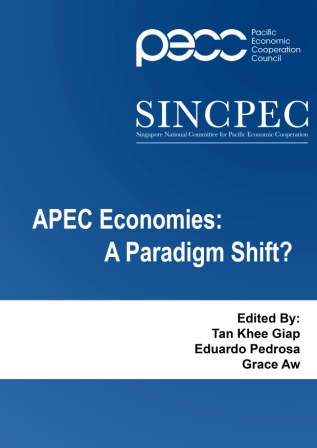 APEC Economies: A paradigm shift? (PDF, 1.71MB)
APEC Economies: A paradigm shift? (PDF, 1.71MB)
88 pages
Edited by: Tan Khee Giap, Eduardo Pedrosa, and Grace Aw
Based on SINCPEC Conference, Singapore, April 2012
Executive Summary
The 2012 SINCPEC conference was held back-to-back with the PECC’s Standing Committee. This SINCPEC conference was a prelude to the APEC meetings held in Vladivostok in September 2012.
The objective of this conference was to provide ideas and suggestion on the major issues that leaders of the Asia-Pacific region have identified, focusing on further trade liberalization, nurturing Asia-Pacific growth with paradigm shift and potential structural change needed, as well as securing future growth through functional cooperation.
The wide range of discussions held at the SINCPEC conference set the scene for the PECC Standing Committee meeting, where members deliberated on the future role of the organization and its relevance to the region.
The first plenary session on ‘Further Trade Liberalization for APEC Economies’ addressed issues relating to Trans-Pacific Partnership agreement, invigorating trade and investment liberalization and facilitation in the Asia Pacific. Three topics were covered in this section: Trade Liberalization within the Regional Economic Architecture; Consolidating Sub-Regional Initiatives: The EAFTA as Catalyst; The Completion of the ASEAN Economic Community 2015.
The session on ‘Trade Liberalization within the Regional Economic Architecture’ described the regional economic architecture as concentric circles with ASEAN and APEC at the core, respectively. These concentric circles are expected to form the pathway for a free trade area of the Asia-Pacific, which is important to maintain regional peace and stability.
‘Consolidating Sub-Regional Initiatives: The EAFTA as Catalyst’ discussed the obstacles that exist in the establishment of a region-wide East Asia free trade area, and the options possible in the face of these obstacles. The economic integration in Northeast Asia was also discussed, as well as Korea’s position on regional economic integration.
The section on ‘The Completion of the ASEAN Economic Community 2015’ considered the motivation to achieve the ASEAN Economic Community by 2015, and how far ASEAN is away from this target.
The second plenary session on ‘Nurturing Asia Pacific Growth in the Aftermath of the Fiscal Crises in Europe: Paradigm Shift and Structural Change Needed’ will discussed how APEC economies can cope with external debt and ensure fiscal sustainability. The session began with a discussion on Russia’s objectives in APEC, and was followed by a presentation on the motives driving Japan’s contributions to ASEAN. This plenary session ended with the lessons that Asian economies can learn from the on-going European fiscal crisis, and introduced a simple measure of fiscal sustainability that governments can use as an early warning signal.
The third plenary session was on ‘Securing Future Growth through Functional Cooperation’. The first section on ‘Healthcare as an Inclusive Growth Sector’ discussed why healthcare is a key element of any kind of inclusive growth. Moreover, this section explained the importance and difference of living well versus just living longer, and what governments can do to help citizens to live well.
Food security is one of APEC’s 2012 priorities. The session on ‘Food Security in APEC Economies’ elaborates why food reserves are rising in importance, and how APEC can be used as a platform to meet emergency food needs.
‘Energy Security in APEC Economies’ focused on energy security, a key global issue. The paradigm shift in the gas markets in the APEC region was discussed, and the developments in the outlook for global natural gas trade was used to suggest how the concept of energy security will evolve in the light of technological progress and associated changes in estimates of resource reserves.
The following session on ‘Infrastructures and Connectivity in Asia-Pacific: The Case of Mainland ASEAN Economies’ talks about the kind of quality growth ASEAN should aim for in the future.
The fourth plenary session was on ‘Nurturing Asia Pacific Growth: Competitiveness Enhancement and Productivity Drive for APEC Economies’. The first of the four topics of this plenary session was on ‘Competitive Challenges in Uncertain Times’. This section discussed the importance of a favorable international architecture, and the importance of involvement of the business and government, for fostering future prosperity. The discussion highlighted the importance of the PECC and APEC agendas to the future of their members.
The second topic is on ‘Addressing Labor Market Mix, Enhancing International Competitiveness and Growing Inclusivity: The Singapore Case’. This session looked at the Singaporean experience on competitiveness, and alternative approaches in enhancing international competitiveness through wages-productivity-competitiveness nexus. This section also discussed the broad principles to mitigate income disparity and labor market failure.
The third topic on ‘Market Forces versus Market Failure for Private Sector Competitiveness’ described the Philippines experience and highlighted the challenges that developing economies face as they try to be more competitive.
The final topic in plenary session four is on ‘Competitiveness Enhancement: Business Financing and Capital Market Reform in China’, and the focus of this topic was on China’s capital markets and financing channels, its investor landscape, as well as the problems China faces in its capital market reforms.
The fifth plenary session was on ‘The Future Role and Continued Relevance of PECC’. This session discussed the issues relating to the strategic importance of regionalveconomic integration and cooperation vis-a-vis Asia-Pacific Economic Cooperation (APEC), East Asian Summit (EAS), Group of Twenty (G-20) and Global Governance Group (3G).
This conference was co-organized by the Pacific Economic Cooperation Council (PECC), and the Singapore National Committee for Pacific Economic Cooperation (SINCPEC) in April 2012.

 APEC Economies: A paradigm shift?
APEC Economies: A paradigm shift?